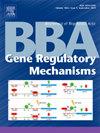rna -蛋白质相互作用技术-历史和比较分析。
IF 3.1
3区 生物学
Q3 BIOCHEMISTRY & MOLECULAR BIOLOGY
Biochimica et Biophysica Acta-Gene Regulatory Mechanisms
Pub Date : 2025-09-11
DOI:10.1016/j.bbagrm.2025.195115
引用次数: 0
摘要
rna复杂地协调着无数的分子和细胞过程。这包括作为蛋白质合成基本蓝图的mrna和作为多种调节因子,影响基因表达、RNA稳定性甚至蛋白质功能的非编码RNA。在过去的几十年里,出现了一系列以RNA和蛋白质为中心的方法来辨别和阐明RNA结合蛋白(rbp)和参与RNA-蛋白质相互作用(RPI)的RNA的身份。考虑到每种技术的独特优势和固有局限性,为了有效地处理特定的生物学调查,选择适当的方法是至关重要的。这篇综述涵盖了rna -蛋白质相互作用研究中使用的技术范围,从历史悠久的方法,如电泳迁移转移测定(EMSA)到现代方法,如基于crispr的rna -蛋白质相互作用分析(CBRIP)。本文不仅列出了各种方法,而且还提供了历史背景,讨论了每种方法的优缺点,并强调了它们目前的应用。此外,它还根据rna -蛋白质相互作用的不同目的,整合了专门用于表征它们的方法。本文章由计算机程序翻译,如有差异,请以英文原文为准。
RNA-protein interaction techniques - A historical and comparative analysis
RNAs intricately orchestrate a myriad of molecular and cellular processes. This includes mRNAs which serve as the essential blueprints for protein synthesis and the non-coding RNAs which act as versatile regulators, influencing gene expression, RNA stability, and even protein function. Over the past few decades, a diverse array of RNA- and protein-centric methodologies have emerged to discern and elucidate the identities of RNA binding proteins (RBPs) and RNAs engaged in RNA-Protein interactions (RPI). The selection of an appropriate method is paramount, given the distinctive advantages and limitations inherent to each technique, in order to effectively address specific biological inquiries. This review spans the spectrum of techniques employed in RNA-Protein interaction studies, ranging from time-honored methods like Electrophoretic Mobility Shift Assay (EMSA) to contemporary approaches such as CRISPR-based RNA-Protein interaction profiling (CBRIP). This review aims not only to list methods but also to provide historical background, discuss the strengths and weaknesses of each approach, and highlight their current applications. Furthermore, it consolidates methodologies tailored to characterize RNA-protein interactions based on their distinct purposes.
求助全文
通过发布文献求助,成功后即可免费获取论文全文。
去求助
来源期刊
CiteScore
9.20
自引率
2.10%
发文量
63
审稿时长
44 days
期刊介绍:
BBA Gene Regulatory Mechanisms includes reports that describe novel insights into mechanisms of transcriptional, post-transcriptional and translational gene regulation. Special emphasis is placed on papers that identify epigenetic mechanisms of gene regulation, including chromatin, modification, and remodeling. This section also encompasses mechanistic studies of regulatory proteins and protein complexes; regulatory or mechanistic aspects of RNA processing; regulation of expression by small RNAs; genomic analysis of gene expression patterns; and modeling of gene regulatory pathways. Papers describing gene promoters, enhancers, silencers or other regulatory DNA regions must incorporate significant functions studies.

 求助内容:
求助内容: 应助结果提醒方式:
应助结果提醒方式:


